Games at the Falls
Pevans was at the 2012 Gathering of Friends
My report is written as a narrative to be read through and focuses on the new (to me) games I played. You can use the indexes below to take you to specific sections or games.
It is also available as a PDF document: Gathering of Friends 2012 report (3.2 Mb). (You will need Adobe Reader to view this document – use the link to download it if necessary.)
- Introduction – getting there
- My first day – from Africana to Zong Shi
- Day 2 – Village versus Helvetia
- Day 3 – atomic bombs and Pacific islands
- Days 4 and 5 – Space Opera, prizes and heading home
- List of Games
- About the Gathering
List of games
| Title | Publisher/Distributor | Pevans's (highly subjective) rating |
|---|---|---|
| 1812 – the Invasion of Canada | Academy Games | 7/10 |
| Abaddon | Toy Vault | 5/10 |
| Africana | Abacusspiele and Z-Man Games | 7/10 |
| Eclipse | Lautapelit | 8/10 |
| Flash Point: Fire Rescue | Indie Boards and Cards | 8/10 |
| Hawaii | Hans im Glück and Rio Grande Games | 7/10 |
| Helvetia | Kosmos | 9/10 |
| Kingdom of Solomon | Minion Games | 8/10 |
| Last Will | Czech Games Edition and Rio Grande Games | 8/10 |
| Lords of Waterdeep | Wizards of the Coast | 8/10 |
| Manhattan Project, The | Minion Games | 8/10 |
| Village | Eggertspiele and Tasty Minstrel Games | 6/10 |
| Zong Shi | Gryphon Games | 7/10 |
About the Gathering
This year’s event was the 23rd Gathering of Friends, which started out as a weekend get-together by a bunch of gamers, led by Alan Moon (now well known as the designer of Airlines, Elfenland, Ticket to Ride et al). The following year they did it again, bringing some friends with them. This is the abiding principle of the Gathering of Friends: everybody who comes is a friend (and is invited by Alan). This makes for a very convivial, relaxed atmosphere in which anyone can walk up to anyone and ask to join or start a game. Never mind six degrees of separation; at the Gathering it’s hard to find someone more than two degrees away!
Over the years, the Gathering has expanded in time and space: the 2012 event had some 300 attendees over nine full days (though not everybody was there for the whole time). It has moved, arriving in Niagara Falls in 2011 after several years in Columbus, Ohio. There is an increasing business element to the Gathering, as well. Games designers bring prototypes to test and show to the publishers who attend. However, the emphasis remains on playing games and having fun. The event would be recognisable to anyone who’s attended any gamer-organised convention in the UK. It consists of people playing games – most of which they’ve brought with them and made available to everyone else. It’s always a great few days.
Introduction
My trip to America was going smoothly right up until the plane taxied away from the terminal at Heathrow. The pilot came on the intercom: “We seem to have a problem…” Back to the gate to await an engineer. Half an hour later, the engineer had diagnosed a faulty pitot tube (used to measure airspeed) – an hour would be needed to replace it. Oh, and then another hour to test it… Three hours late we had another go at setting off and, this time, made it into the air.
So I was three hours late arriving at Chicago airport. Now, there was four hours between the scheduled arrival of my trans-Atlantic flight and the departure of my connecting flight to Buffalo. Being three hours late was just too late once you factor in collecting luggage, queuing for US Immigration and transferring to another terminal. American Airlines impressed me, though. By the time we landed in Chicago, they’d re-booked everybody who’d missed their connections onto later flights. As we disembarked, two of their staff were waiting with replacement boarding passes and meal vouchers for us.
I was able to re-book my airport shuttle for the later flight and got to the hotel in Niagara Falls a mere 4½ hours late – a major improvement on last year’s 23 hours late! :-)
After that it was time for five days of playing games and chatting to friends, old and new, with a bit of eating and drinking thrown in. However, my topic here is the new (to me, at least) games I played. I’ll cover these in chronological order, so there should be no discernible pattern to what follows.
Wednesday
My first game was Africana, a Michael Schacht design just published by Abacus (with the English language edition coming from Z-Man Games). I find Mr Schacht’s games a bit hit and miss – some I like, some I don’t – so I was interested to see what this one was like. The game is set during the European exploration of Africa with players adding their ‘explorers’ to ‘expeditions’ and collecting artefacts from across the continent – possibly with the aid of native guides.
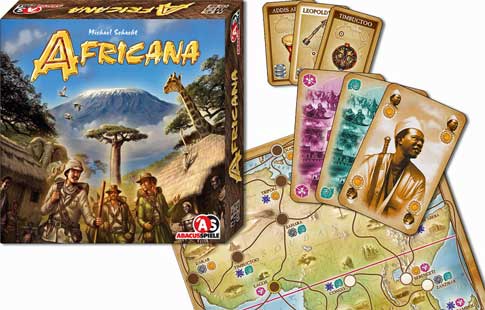
All of this is done through playing cards. Each player has a hand of movement cards and can play a sequence of these to move from location to location across the map of Africa on the board (the native guides are cards you can pick up again after using them, so they help you move faster, but score minus points at the end of the game). On display at the bottom of the board are a number of expeditions: cards that show two locations. Entering the starting location lets players place a token on the card and gain a bonus (in movement cards or coins). They get the card when they reach the destination shown – provided no-one else beat them to it. The cards provide an immediate payout and points at the end of the game.
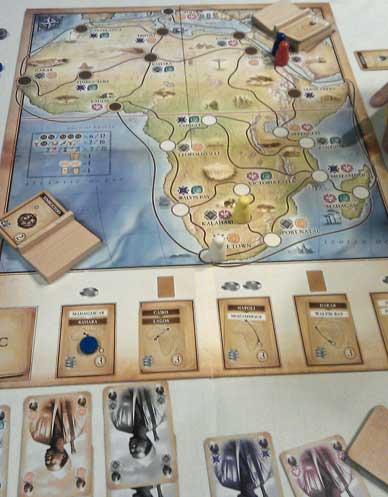 On top of this, there are sets of artefact cards which players can buy. To then claim the artefact, however, they must visit the location shown on the card. Clearly, it’s useful if you can collect artefacts and start/complete expeditions in the same place. However, you score points for having sets of the same artefact at the end of the game, so you have to weigh up the value of artefacts and expeditions
if they’re taking you in different directions.
On top of this, there are sets of artefact cards which players can buy. To then claim the artefact, however, they must visit the location shown on the card. Clearly, it’s useful if you can collect artefacts and start/complete expeditions in the same place. However, you score points for having sets of the same artefact at the end of the game, so you have to weigh up the value of artefacts and expeditions
if they’re taking you in different directions.
You can only do one thing each turn: move your pawn, collect movement cards or buy artefacts. The game ends when the expeditions run out, players tot up their points and whoever has the most wins. Africana is, in effect, a pick-up-and-deliver game with a few wrinkles – and none the worse for that as I like pick-up-and-deliver games. One wrinkle is that it’s worth ‘joining expeditions’ you have no intention of completing just to get the bonus.
I found Africana less challenging than many of Michael Schacht’s designs, but it is an attractive and entertaining game. I thoroughly enjoyed it, though I was ready for it to end fifteen minutes before it did. I give it a provisional 7/10 on my highly subjective scale. Africana is for 2-4 players, aged 8+ and takes about 60 minutes to play.
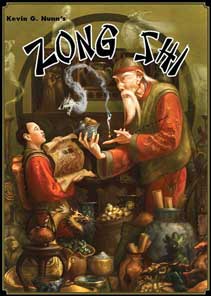 My first game started with an ‘A’, my second was a ‘Z’. Zong Shi is designed by Kevin G Nunn (the man who gave us Nobody but us Chickens) and just published by Gryphon Games. As the name suggests, this has a Chinese setting. Players have two ‘artisan’ pawns – a master and an apprentice – and are competing to become Grand Master. They
do this by completing projects: ordinary ones that give some bonus towards later projects or masterworks that help them win. However, players
can also curry favour with influential
townsfolk by giving them presents – in other words, it’s not enough to be good at what you do, you need a bit of politicking too!
My first game started with an ‘A’, my second was a ‘Z’. Zong Shi is designed by Kevin G Nunn (the man who gave us Nobody but us Chickens) and just published by Gryphon Games. As the name suggests, this has a Chinese setting. Players have two ‘artisan’ pawns – a master and an apprentice – and are competing to become Grand Master. They
do this by completing projects: ordinary ones that give some bonus towards later projects or masterworks that help them win. However, players
can also curry favour with influential
townsfolk by giving them presents – in other words, it’s not enough to be good at what you do, you need a bit of politicking too!
The main mechanism of the game is placing your pawns on actions each turn: buying raw materials, visiting townsfolk, picking up scrolls (which provide bonuses) from the temple or working on a project. The master can do more of each of these than the apprentice and only the master can work on a project. Another neat mechanism is that projects take several turns to complete. Hence you need to think about starting projects, as you know you’ll be deprived of your master for a while.
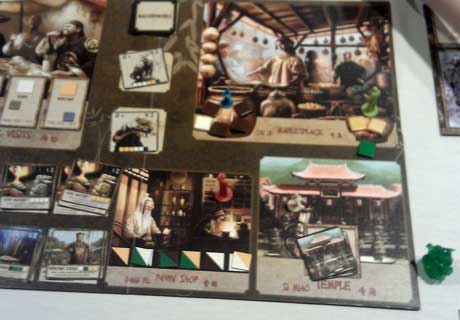 The game ends when (at least) one player has completed six projects. Players add up their points from projects, visits and leftover materials and whoever has the most wins. The obvious strategy is to work up through the projects, completing easy ones initially to make the masterworks cheaper and/or faster. An alternative strategy would be to concentrate on cheap projects, looking
to finish
the game quickly before anyone can get a masterwork done. However, on first play the masterworks look too valuable
for this to work – unless the other players don’t spot what you’re up to.
The game ends when (at least) one player has completed six projects. Players add up their points from projects, visits and leftover materials and whoever has the most wins. The obvious strategy is to work up through the projects, completing easy ones initially to make the masterworks cheaper and/or faster. An alternative strategy would be to concentrate on cheap projects, looking
to finish
the game quickly before anyone can get a masterwork done. However, on first play the masterworks look too valuable
for this to work – unless the other players don’t spot what you’re up to.
The other thing to note is that there are plenty of points available on other ways – such as the visits – as well as completing masterworks. This gives players several strategies and variations on these, which should mean there’s plenty of replay value in Zong Shi. The game is gorgeously produced with great artwork and some lovely playing pieces – notably the translucent green Buddha that denotes the first player. I enjoyed the game on my first acquaintance, but it didn’t really grab me. One to try again, I think, and I give it a provisional 7/10 on my highly subjective scale. Zong Shi is for 3-5 players, aged 13+ and takes about 75 minutes to play.
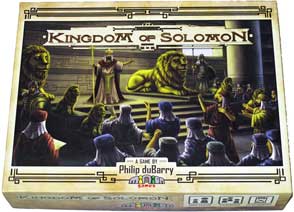 Next up was Kingdom of Solomon, which looked intriguing. Designed by Philip duBarry, it’s one of last year’s crop from Minion Games, a relatively new US publisher. As the name suggests, the game is set in ancient Israel. This is depicted on the board, divided into areas and showing the material that each area produces. The board also shows the various roles/actions available
to players each turn, the market where materials can be bought or sold and a schematic of the temple,
whose construction players
can contribute to.
Next up was Kingdom of Solomon, which looked intriguing. Designed by Philip duBarry, it’s one of last year’s crop from Minion Games, a relatively new US publisher. As the name suggests, the game is set in ancient Israel. This is depicted on the board, divided into areas and showing the material that each area produces. The board also shows the various roles/actions available
to players each turn, the market where materials can be bought or sold and a schematic of the temple,
whose construction players
can contribute to.
In time-honoured fashion, players take it in turns to place one of their pawns to take the corresponding action. They go on the map to get the resources from an area or on an action to get that action. One neat touch is that the most useful actions require a player to go ‘all in’ – that is, place all their remaining pawns on that space. This adds to the interesting decisions facing players – not just the cost of the action, but getting it before anyone else.
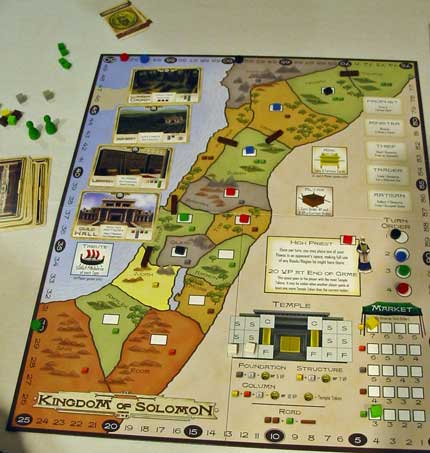 Once all the pawns are down, players get to take their actions and resources. Then they can buy and sell materials at the market. After this, players get the chance to build things. Materials can be used to buy buildings (cards). These provide extra resources and benefits during the game and are a major source of victory points at the end.
Once all the pawns are down, players get to take their actions and resources. Then they can buy and sell materials at the market. After this, players get the chance to build things. Materials can be used to buy buildings (cards). These provide extra resources and benefits during the game and are a major source of victory points at the end.
Players can also add to the Temple or build roads to connect areas, allowing them to gain multiple resources with one placement in the future. The player who’s contributed most to the Temple is High Priest, which gets them an advantage during the game and a big pile of points at the end – though not necessarily enough to win.
The game ends when one of several things runs out. Players add any final bonus points and the winner is whoever has the most points, of course. Okay, there’s nothing revolutionary in Kingdom of Solomon, but it is nicely done and has some clever touches – as well as an interesting theme. I found it rather appealing, despite the rather basic production. It’s a provisional 8/10 on my highly subjective scale. Kingdom of Solomon is for 2-4 players, aged 12+ and takes about 60 minutes to play.
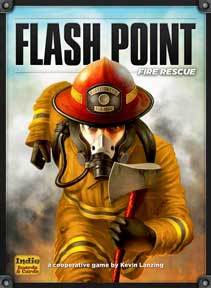 It was time for something lighter and that was Flash Point: Fire Rescue, from Indie Boards and Cards. This is a departure from Indie’s usual fare of card games and a game I didn’t get to try at Spiel last year. Designed by Kevin Lanzing, this is a co-operative game: the players are a team of fire-fighters trying to rescue people from a burning building. Each of them
has different abilities, so it makes sense for the players to specialise in their particular role. What’s
more,
you can swap roles to bring
in other specialists when the team needs them.
It was time for something lighter and that was Flash Point: Fire Rescue, from Indie Boards and Cards. This is a departure from Indie’s usual fare of card games and a game I didn’t get to try at Spiel last year. Designed by Kevin Lanzing, this is a co-operative game: the players are a team of fire-fighters trying to rescue people from a burning building. Each of them
has different abilities, so it makes sense for the players to specialise in their particular role. What’s
more,
you can swap roles to bring
in other specialists when the team needs them.
You start with a building (board) that’s already on fire and containing people – markers that can be dummies. Players move their pieces, manoeuvring through doors or even chopping through walls, to get to the fire and/or people. The former they try to put out, the latter they carry out of the building. However, each turn they also roll dice to see if the fire spreads. Roll a square that’s already got fire in and you get an explosion that spreads the fire even further.
Flash Point is both atmospheric and challenging. You really feel that you’re under pressure as fire springs up in areas you thought were cleared. Even more disconcertingly, so do people (and pets!). The players win if they get a certain number of people out, but lose if too many are lost to the fire – or the building collapses! The Advanced rules, which we were playing, provide more features, including the fire truck, which can be used to douse a whole quadrant of the building.
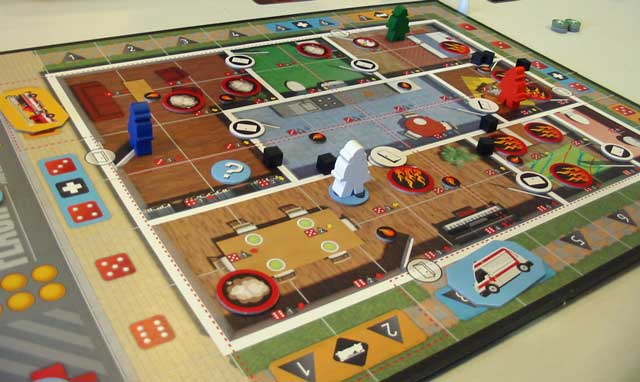
It’s all too easy to lose this game, but you also don’t want to spend too long debating who’s going to do what each turn – it’s an emergency! We enjoyed it so much that we played three games on the trot, using the different boards and playing different roles. The box contained an expansion that provides different buildings, such as the apartment block where there’s no access from the outside (it’s several floors up), and additional roles.
Flash Point: Fire Rescue is good fun and a great topic for co-operative play since fire-fighters must work as a team. I’ll give it 8/10 on first acquaintance, though co-operative games are a rather different kettle of fish from my usual fare. I think gamers will want to play the advanced game as it isn’t too complex to pick up from scratch and it seems to provide more depth to the experience. Flash Point: Fire Rescue is for 1-6 players, aged 10+ and takes about 45 minutes to play.
Thursday
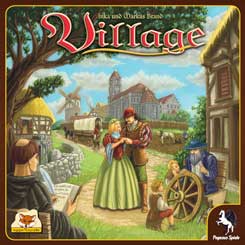 My second day opened with Village, which is published by Eggertspiele – the latest of their games designed by Inka and Markus Brand. It was launched at Spiel last year, but this was my first opportunity to play it. The board shows a medieval village with different actions illustrated at each building. Players have their own ‘farmyard’ board and several generations of worker pawns.
The individual boards also have a time track. Most actions use up time and each circuit of the
board kills off a pawn – generation
by generation.
My second day opened with Village, which is published by Eggertspiele – the latest of their games designed by Inka and Markus Brand. It was launched at Spiel last year, but this was my first opportunity to play it. The board shows a medieval village with different actions illustrated at each building. Players have their own ‘farmyard’ board and several generations of worker pawns.
The individual boards also have a time track. Most actions use up time and each circuit of the
board kills off a pawn – generation
by generation.
As you’d expect, players place workers on buildings to get the use of the actions available, taking an ‘influence’ cube when they do so. In this game, players also have to pay to use the actions, spending time or resources. Thus, placing a worker gets you access to the action for some time. Placing a worker is significant in other ways. First is the question of which cube you take: sometimes getting the cube is more important than the action available to the worker you’ve just placed.
The second thing is that it matters where your workers are when they die. They go into the relevant section of the ‘village chronicle’ and players get additional points at the end of the game for their pieces in the chronicle. If there’s no space in the right part of the chronicle, dead workers go into the general graveyard and the game ends when either this or the chronicle fills up. So, in this game, death is not only inevitable but part and parcel of the game play.
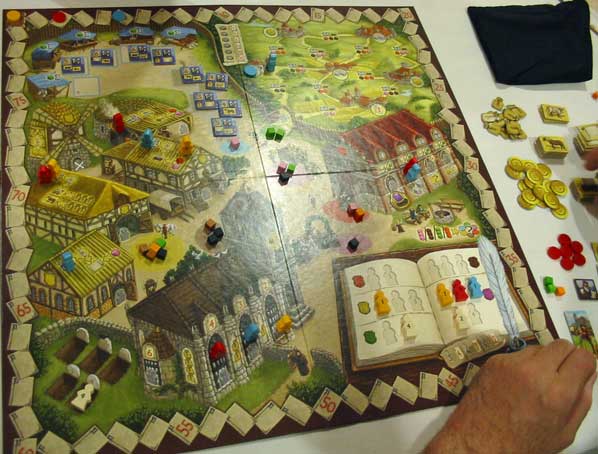
The aim of the game is to have the most points at the end, of course. Players can pursue this by travelling, joining the village council or the church, working at the various crafts or trading at the market. You will probably do all of these through the game, but I suspect that it’s specialising that will bring in the big points.
My initial reaction to Village was that, while challenging, it was dry and uninspiring. Hence I give it 6/10 on my highly subjective scale. However, the mistake I made in my first game was thinking that I should try to avoid killing off my workers. Spending to get my first generation into good positions (in the council and church) was counter-productive as they were always bound to die. I clearly need to give it another go with a proper understanding of how the game works. Village is for 2-4 players, aged 12+ and takes about 75 minutes to play.
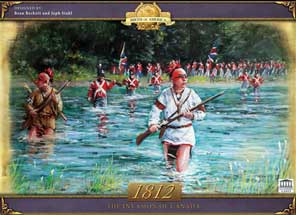 A change of pace was Academy Games’s 1812 – the Invasion of Canada, a wargame of the War of 1812 – when the USA took advantage of the British being busy fighting Napoleon to invade Canada. We played the five-player version: two players on the US side – regular army and militia – and three on the other – British army, Canadian militia
and Native Americans. The forces are represented rather abstractly with wooden cubes of different colours.
A change of pace was Academy Games’s 1812 – the Invasion of Canada, a wargame of the War of 1812 – when the USA took advantage of the British being busy fighting Napoleon to invade Canada. We played the five-player version: two players on the US side – regular army and militia – and three on the other – British army, Canadian militia
and Native Americans. The forces are represented rather abstractly with wooden cubes of different colours.
In contrast, the board is, of course, a map of the territory the war was fought over, the land divided by the Great Lakes and the rivers. It is divided into areas, with icons to show those of particular significance. These are marked with British or American flags when they are held by the opposition. Whichever side has more markers on the board at the end of the game wins the war.
Turn order is decided randomly each round with each player playing a card that allows them to move a number of armies over land (a maximum number of spaces) or by sea. An army is any collection of cubes that contains at least one of the player’s. Once they’ve moved, battles are fought by rolling dice. Each of the five types of force has their own dice, making them more or less effective. Players roll as many dice as they have cubes involved in the battle, to the maximum available to them – the British regulars have three dice, for example.
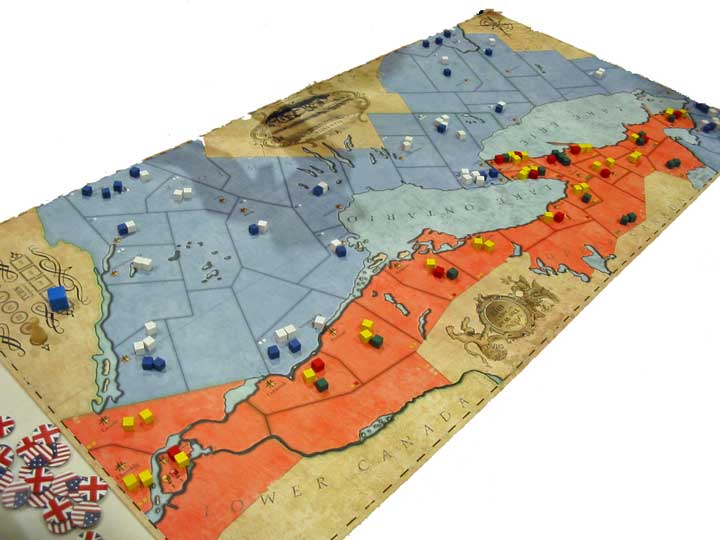
1812 about to start
The dice will show a hit, removing a cube from the opposition, a ‘flee’ symbol, removing one of your own cubes for re-deployment next turn, or a blank. The blank isn’t all bad news as each of them does allow a cube to make a strategic withdrawal – very useful if you’re an outnumbered defender. The Native Americans also have the useful tactical advantage of being able to withdraw to enemy territory, in effect capturing it!
Each set of cards includes one ‘truce’ card. The game ends when all the truce cards of one side have been played. Our game ended quite quickly with us Brits trouncing the damn’ Yankees – helped by the inability of the American militia player to roll hits! 1812 proved an entertaining game that worked well as a multi-player wargame. I suspect the conferences between each team slowed things down a bit, though. I give it 7/10 on my highly subjective scale. Designed by Beau Beckett and Jeph Stahl, 1812 is for 2-5 players, aged 10+ and takes about 90 minutes to play.
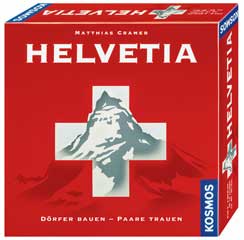 After which, I was recruited to try Helvetia, a Kosmos game designed by Matthias Cramer. Each player starts with a village square and three buildings, staffed with villagers, that produce different goods – more villagers are married into other players’ villages. Players can use their own villagers to produce goods, wherever they are, but only married couples in your village
produce more villagers (babies, initially, who must then go to school before they can be deployed –
though you can marry them off
straight from school!).
After which, I was recruited to try Helvetia, a Kosmos game designed by Matthias Cramer. Each player starts with a village square and three buildings, staffed with villagers, that produce different goods – more villagers are married into other players’ villages. Players can use their own villagers to produce goods, wherever they are, but only married couples in your village
produce more villagers (babies, initially, who must then go to school before they can be deployed –
though you can marry them off
straight from school!).
There are no goods pieces in the game, players simply lay down the appropriate villagers to show they’ve used what those workers produce. And there is a chain of production, too, so producing a cow bell (a good Swiss staple) requires metal, which in turn requires ore. A chart on the central board shows all the different goods. Players can use up a good to place a marker on the appropriate space on the chart. Each marker is worth a point and there’s a bonus for the first to place a marker on the more complex goods. There are substantial bonuses, too, for the first to place specific sets of markers – like the ore-metal-cow bell sequence.
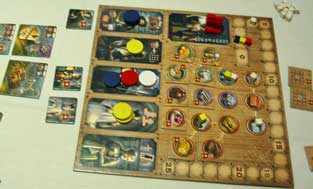
The Helvetia main board
The central board shows the five actions available to players each turn. They take actions by placing discs on them – as many discs as the number of times they want to do the action – and then carry them out. Constructing buildings is, of course, an action. So is placing markers for goods produced. Standing workers back up again is the third. Conducting marriages is the fourth and producing babies is the last. Players continue taking actions until only one of them has any discs left. They don’t get to use those discs (a tactical point to be aware of), but do get the first player marker for next time (it’s worth a point, too).
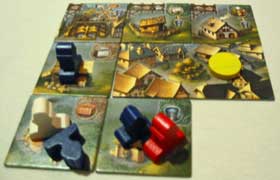
My Helvetia village during play
Rather than scoring points for actions, players assess their current points at the end of each round – and points can go down as well as up! The game ends when at least one person reaches 20 points and whoever has the most points wins. While there are quite a few points available in bonuses, expect to get most of your points from markers on the production spaces.
I found Helvetia great fun, belying the initial impression of the very dull artwork on the box – it’s one of the few games I played more than once at the Gathering. In particular, it plays quickly and reaches a conclusion almost before you’re ready for it. “Leave ’em wanting more” is a good principle for games design and I think this is the difference between Helvetia and the superficially similar Village. I give Helvetia an initial 9/10 on my highly subjective scale. It is for 2-4 players, aged 12+ and takes 90 minutes to play.
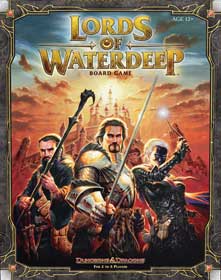 I had been hearing good things about Lords of Waterdeep since I arrived, so I jumped at the opportunity to try it. It turned out to be a bit of a masterclass from Hasbro’s Mike Gray, who didn’t seem to be paying much attention to the game, but ran away with it. Again, this game is about placing workers to get resources and actions. There are buildings to
construct, too,
but at the heart of Lords of Waterdeep are the quests that players seek to fulfil.
I had been hearing good things about Lords of Waterdeep since I arrived, so I jumped at the opportunity to try it. It turned out to be a bit of a masterclass from Hasbro’s Mike Gray, who didn’t seem to be paying much attention to the game, but ran away with it. Again, this game is about placing workers to get resources and actions. There are buildings to
construct, too,
but at the heart of Lords of Waterdeep are the quests that players seek to fulfil.
First, the culture shock: it’s a Dungeons & Dragons board game from Wizards of the Coast! Other than the logo, though, there’s nothing particularly D&D about this game. Okay, the wooden cubes you collect are adventurers of different classes, rather than types of resource, but that’s just the labels. I spotted familiar denizens from the Monster Manual, too.
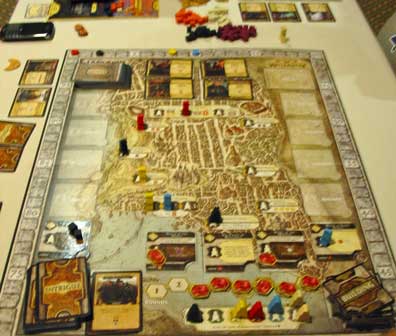 The board shows the city of Waterdeep and the specific buildings where players will place their ‘agents’ to recruit adventurers, find quests and intrigue against their opponents. As there’s only room for one piece at most buildings, turn order is significant – so it’s no surprise that one of the buildings makes you first player. Another building lets you draft a ‘Quest’ card – you can have
several on the go at the same time. When you have the right mix of adventurers (cubes) and cash, you can complete
the quest and get whatever reward it provides.
The board shows the city of Waterdeep and the specific buildings where players will place their ‘agents’ to recruit adventurers, find quests and intrigue against their opponents. As there’s only room for one piece at most buildings, turn order is significant – so it’s no surprise that one of the buildings makes you first player. Another building lets you draft a ‘Quest’ card – you can have
several on the go at the same time. When you have the right mix of adventurers (cubes) and cash, you can complete
the quest and get whatever reward it provides.
Victory points are, of course, one of the things you get from completing quests. However, some also give you more cubes and/or money. A tactical point here is using one quest to provide what you need for another. Some of the quests are identified as a “plot quest”. These provide few victory points but instead give you some advantage for the rest of the game. The earlier you can pick these up, the more useful they are.
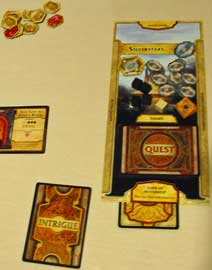 Lords of Waterdeep player's board et al
Lords of Waterdeep player's board et al
Apart from quests, players can buy more buildings for the town, giving extra options for placing agents and more opportunities to gain things. They can play ‘Intrigue’ cards, which provide bonuses or interfere with other players. For example, a mandatory quest is played on another player, requiring them to complete it before they can finish any other quest. The agent used to play an Intrigue card (after all agents have been placed) is then re-deployed to an empty building, getting you a second action.
Lords of Waterdeep plays really well. Players are always challenged to finish their quests – both by the game system and their opponents. The game is played over a set number of turns, so getting your quests completed in time adds to the pressure and the game does not outstay its welcome. The whole thing is good fun and this is another game that I played more than once. Lords of Waterdeep gets 8/10 on my highly subjective scale. Designed by Peter Lee and Rodney Thompson, it is for 2-5 players, aged 12+ and takes about 60 minutes to play.
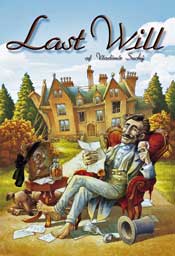 Last Will was one of the interesting games that I missed at Spiel ’11, so it was one I definitely wanted to play. It’s designed by Vladimir Suchy, one of the stalwarts of Czech Games Edition (with the English language edition coming from Rio Grande Games). The idea of the game is Brewster’s Millions: that is, the players must get rid of all their money to show that they are worthy to inherit
a fortune. It’s certainly a clever idea.
Last Will was one of the interesting games that I missed at Spiel ’11, so it was one I definitely wanted to play. It’s designed by Vladimir Suchy, one of the stalwarts of Czech Games Edition (with the English language edition coming from Rio Grande Games). The idea of the game is Brewster’s Millions: that is, the players must get rid of all their money to show that they are worthy to inherit
a fortune. It’s certainly a clever idea.
In game terms, the players try to build up a set of cards that will cost them money each turn – such as the impecunious School Chum. In particular, they can buy property. Properties can be maintained – which costs money, of course – or allowed to decay, which means they lose value. Ideally, you then sell the property at a thumping loss. Players can also manipulate the market to give different types of property a premium (when buying) or a discount (when you want to sell).
For such a light-hearted theme, the game is actually quite intricate and requires a bit of thought. First, each turn players must choose a slot on the ‘planning board’. This will give them a certain number of actions, so many cards and put them somewhere in the order of play for the turn. As player order affects who gets what cards, this can be the most important element – provided you then have the actions needed to use the cards you want. Alternatively, you could go for the actions you need only to find someone else nipping ahead of you and grabbing the cards for which you needed the actions. Decisions, decisions.
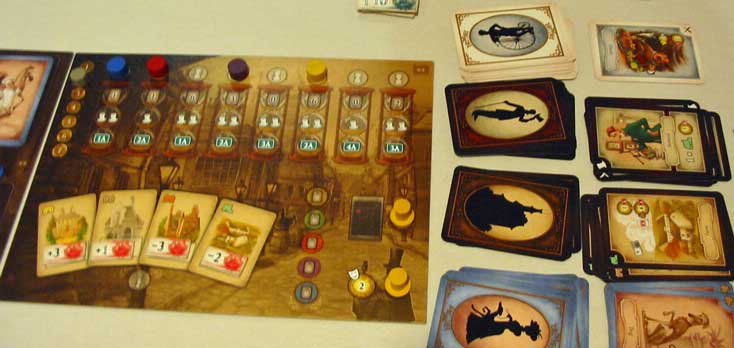 Part of the Last Will board and cards during play
Part of the Last Will board and cards during play
On top of this, there are several different types of cards, which do different things. Some are used once only, some go in front of you as a permanent feature and some are property. There is quite a bit to think about and, ideally, you want to do this at the start of the turn. There is time pressure as well, as the game ends after a certain number of turns – unless someone wins outright by going bankrupt. (The only trick to going bankrupt is that you have to get rid of your property first!)
Last Will was a great romp. There’s enough thinking required to keep you on your toes without damaging any brain cells. The fun theme translates well to the game and it’s surprisingly hard to get rid of the pile of cash you start with (though I haven’t tried simply ‘mislaying’ it onto the floor…). I enjoyed the game on first acquaintance and give it 8/10 on my highly subjective scale. Last Will is for 2-5 players, aged 12+ and takes about 60 minutes to play.
Friday
Lest you think I spent all my time sitting in a hotel ballroom playing games, I did get out to visit the falls on day 3. It’s only a short walk from the hotel to a good viewing area just below the (American) falls and they are just as spectacular as I recall from my first visit some 25 years ago. I’m guessing they must have moved a bit since then (about a foot a year, says Wikipedia), but I certainly couldn’t tell the difference.
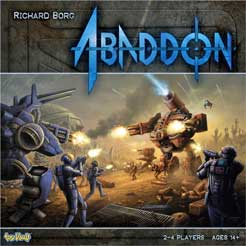 Enough of that: back to the games. Abaddon, I was told, was Memoir ’44/BattleLore/Commands & Colors in space. That is, Richard Borg’s latest development of the game system used in all these games (and the original Battle Cry). I had to give it a go. However, my expectation of coruscating energy beams pitted against lambent force fields as spacecraft
hurtle through the void were cruelly dashed when Chris Kovac and I opened up the box. It’s actually
about hulking great robots knocking chunks off each
other!
Enough of that: back to the games. Abaddon, I was told, was Memoir ’44/BattleLore/Commands & Colors in space. That is, Richard Borg’s latest development of the game system used in all these games (and the original Battle Cry). I had to give it a go. However, my expectation of coruscating energy beams pitted against lambent force fields as spacecraft
hurtle through the void were cruelly dashed when Chris Kovac and I opened up the box. It’s actually
about hulking great robots knocking chunks off each
other!
The twist for this version of the game system is that dice are used to decide which of your units you can move and/or fire each turn, while card play determines the damage done. This seems to work just as well as the reverse, used in the earlier games, with some subtleties. There are no longer areas of the battlefield, for example, as the dice simply activate a specific class of unit. When an attack is made, both sides play a card with the loser taking damage according to the difference between the cards – which means opening fire on someone is not without risk.
Chris and I played the basic scenario, pitting one unit of each type against an identical opposing force. It may have been our card play, but we seemed to do more damage to our own forces by moving into position to attack. Damage is indicated by removing ‘power crystals’ from the bases of the model robots, so the fighting is as much about attrition as blowing things away.
We were underwhelmed by the experience and packed the game away without trying any of the more advanced scenarios. I still like the game system – it’s an excellent simple wargame that provides just enough flavour without getting too complex – but I’m afraid Abaddon doesn’t do it for me. It gets 5/10 on my highly subjective scale, based on this one play. Abaddon is published by Toy Vault, is for 2 players, aged 14+ and takes about 45 minutes to play.
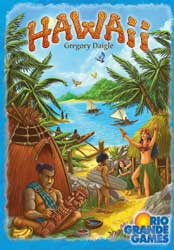 That brings me to another game from Spiel ’11 that I hadn’t played yet. Hawaii is Hans im Glück’s other game from 2011 (the first one being Pantheon, which I discussed in TWJO 116, and ignoring Carcassonne and Dominion expansions). The bright, primary colours and odd-shaped cardboard strips immediately made me think of
Sun, Sea and Sand, but this is a rather different game.
That brings me to another game from Spiel ’11 that I hadn’t played yet. Hawaii is Hans im Glück’s other game from 2011 (the first one being Pantheon, which I discussed in TWJO 116, and ignoring Carcassonne and Dominion expansions). The bright, primary colours and odd-shaped cardboard strips immediately made me think of
Sun, Sea and Sand, but this is a rather different game.
The main playing area holds rectangular tiles that will allow the players to do things. Players’ pieces start on the ‘beach’ at one end of this, so some tiles are easier to reach than others. The tiles are set out randomly each game, which affects players’ tactics for the game. Each round (and there are only a few of these) players use feet to move between tiles and shells to buy things (they also have fruit, which can be used as feet or shells). Purchases go into each player’s own frame, building up their villages as separate rows.
Players can also go fishing or visit another island, which brings different rewards depending on which island it is. The costs of doing these things are set each round by drawing markers from a bag. Clearly, you want the things you do to be cheap. However, at the end of each round, the players who have spent the most will score some points – provided they reached the minimum value for the round. The minima and the points scored increase each round. This is rather clever as it gives players conflicting incentives for what they spend.
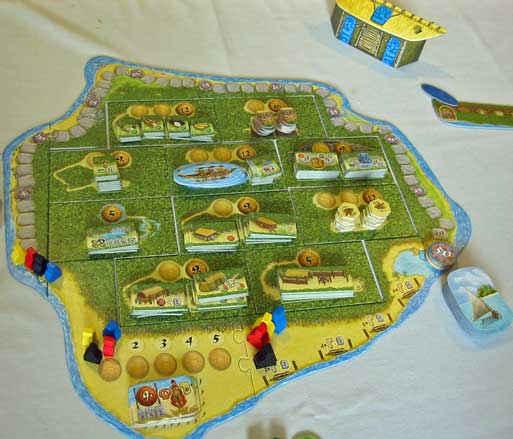 On the beach ready to start Hawaii
On the beach ready to start Hawaii
Players get their production (of feet, shells and fruit) and have another go. After five rounds, there’s a final scoring and the player with the most points wins. The final scoring is a bit involved, but essentially rewards players with lots of villages, big villages and with various bonus items within their villages. Hence, players have to decide which of the scoring opportunities they want to take advantage of. This will influence what players buy during the game, which in turn will depend on what is accessible and/or cheap – and hasn’t been bought by someone else.
Hawaii is quite an involved game with a lot to think about. I found it a bit counter-intuitive and I had to think carefully about what I wanted to achieve. (I should probably have thought harder!) This is no bad thing and I look forward to playing the game again. For now, I give it 7/10 on my highly subjective scale. Hawaii is for 2-5 players, aged 10+ and takes 60-90 minutes to play. It was designed by Greg Daigle and the English language edition comes from Rio Grande Games.
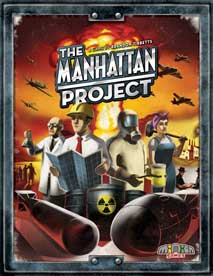 I was hearing good things about Minion Games’s very latest game, The Manhattan Project. Designed by Brandon Tibbetts, this is, as the name suggests, about the race to build the atomic bomb. Each player is a nation running their own research projects and aiming to be first to build the requisite amount of nuclear weaponry. (The Nations expansion
gives each
player a special ability, which adds to the flavour of the game.) The game’s artwork has a wonderful retro Forties feel
– a bit more atmosphere.
I was hearing good things about Minion Games’s very latest game, The Manhattan Project. Designed by Brandon Tibbetts, this is, as the name suggests, about the race to build the atomic bomb. Each player is a nation running their own research projects and aiming to be first to build the requisite amount of nuclear weaponry. (The Nations expansion
gives each
player a special ability, which adds to the flavour of the game.) The game’s artwork has a wonderful retro Forties feel
– a bit more atmosphere.
Players start with three workers (they will need more of these and, in particular, scientists and engineers) and their own display board. This is where they will place their own buildings and keep track of their airpower. The central board shows buildings for sale along with action spaces where players can put their workers. In their turn, players can place one worker on the central board and as many as they like on their own board. However, they have to take a whole turn to get their workers back again. Thus, each turn they have the tactical dilemma: do I get my workers back so I can do lots of things next time or do what I can with the workers available.
Apart from producing more workers, scientists and engineers so that you can do more things, you use your workers to produce ‘yellowcake’, refine it into uranium and build atomic bombs or use it to make plutonium and build H-bombs. Of course, you need scientists to design your bombs (blueprints are drafted from the set of cards available) and engineers to build them and, in the case of nuclear weaponry, test them. And the purpose of airpower is to bomb the factories of anyone who looks like getting there faster than you!
The Manhattan Project was great fun to play – even though I was an abject failure and didn’t build a single bomb. And it’s also quite a subtle game. Initially you need to build up your military-industrial complex to give you the infrastructure. However, you can’t afford to spend too long doing this. I suspect the answer is a happy medium of having just enough infrastructure to build a bomb that’s just big enough…
I give The Manhattan Project an initial 8/10 on my highly subjective scale and look forward to giving the game another go. Perhaps I should look out a copy of Nuclear War to play afterwards…? The Manhattan Project is for 2-5 players, aged 13+ and takes a couple of hours to play (though it felt less).
Saturday and Sunday
The Gathering reaches a climax on the second Saturday (my fourth day). The flea market in the morning is a chance to pick up some secondhand games (though not too many if you’re flying!) and the day ends with speeches (by Alan) and prizes. The prize table is a feature of the Gathering (which Theo and I copied for Furrycon). The idea is that everybody brings a game (of the quality that you would like to take away with you) for the prize table. In random order, everybody gets to choose a game to take away with them. Donations by publishers and extras often mean that there’s more than one game to take away – further strain on the luggage allowance.
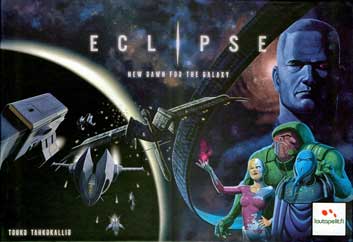 Anyway, my main occupation on the Saturday was playing Eclipse, a mammoth game of galactic exploration and empire-building from Finnish publisher (and distributor) Lautapelit. In traditional (!) manner, the game is played over large, hexagonal tiles that represent star systems. The players start with their home systems (tiles) spread out around the galactic centre tile. In the early
stages of the game, players add extra tiles as they explore, gradually joining up their empires
and, at some point, connecting
to the centre.
Anyway, my main occupation on the Saturday was playing Eclipse, a mammoth game of galactic exploration and empire-building from Finnish publisher (and distributor) Lautapelit. In traditional (!) manner, the game is played over large, hexagonal tiles that represent star systems. The players start with their home systems (tiles) spread out around the galactic centre tile. In the early
stages of the game, players add extra tiles as they explore, gradually joining up their empires
and, at some point, connecting
to the centre.
Each player also has their own board, showing the state of their empire. Crucial to the game is the row of influence discs at the bottom of each board. These are placed to show actions taken and star systems controlled. However, each empty space on the row shows the (increasing) cost of doing this. The bigger your empire and the more you do, the more it costs to run it. This is a very neat touch. How much each player produces is shown in a similar way. Tracks for money, science and materials are covered with cubes. Each cube placed from the track onto a planet increases production to the amount printed on the space. A track round the edge of the board shows the player’s current stock of each.
Then there’s technology. A central board shows what technologies are available for players to ‘research’. By spending the required amount of science, players can add the appropriate technology chip to their own board. Now they can build (using materials) what the technology lets them do: improved guns, power plants and computers for their spaceships and things like wormhole generators to make travelling easier. The final area on players’ board shows what technology they have fitted to the different classes of spaceship.
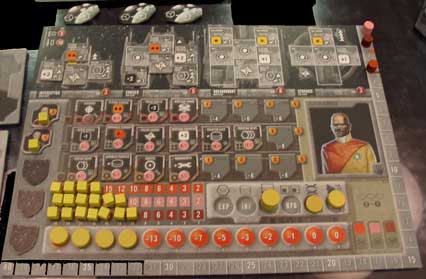 My empire board
My empire board
The spaceships themselves are, of course, spiky little models that give the game some real visual appeal. Moving ships from tile to tile takes a bit of effort (in game terms) and starts a fight when opposing ships move onto the same place. Then it’s down to the weapons, shields and computer systems of the opposing factions’ ships – and the throw of dice. As each player is likely to have developed different technologies, these confrontations can be interesting.
As you’d expect, the game starts with players exploring the galaxy and expanding their empires – in terms of territory, technology and resources. There is conflict too, in the form of dealing with artefacts and ships left behind by the ‘Ancients’. Once empires connect, things get interesting. In a neat touch, players can exchange ambassadors, which gives them both some extra production. Fighting is not inevitable. As my game showed, it is perfectly possible to win by building up your empire and taking opportunities to score points from things like developing technology rather than conquering star systems.
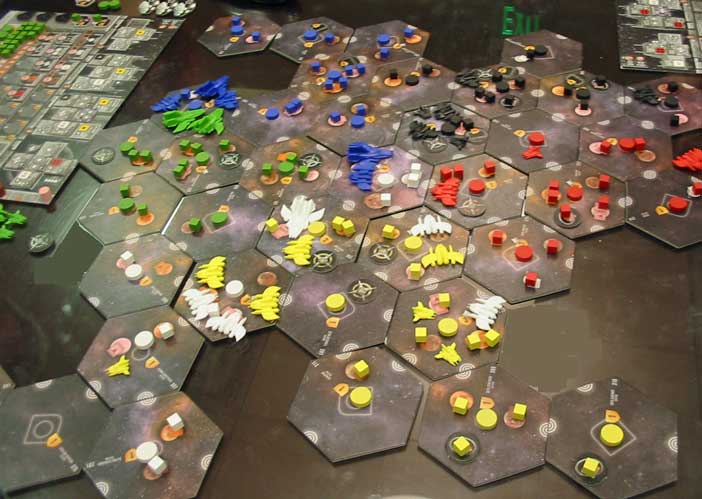 The final confrontation between white and yellow
The final confrontation between white and yellow
I really enjoyed Eclipse. It is quite a complex game, but it is also rewarding and has some very clever touches. One thing I liked was the way the very complexity meant that two players were likely to follow different paths and thus have very different strengths and weaknesses when it came to a confrontation. (I thought I had an edge over the white player with my heavily shielded spaceships, but had failed to notice that he would have the initiative and fire first!) I give it 8/10 on my highly subjective scale based on this first encounter. Designed by Touko Tahkokallio, Eclipse is for 2-6 players, aged 14+ and takes 2-3 hours to play.
The last Sunday of the Gathering is something of an anti-climax. People start leaving after the prizes and there is a steady stream of goodbyes to be said through Saturday evening and Sunday. There is just time for one last tournament. Tournaments used to be a major feature of the Gathering, but they are more background events these days. However, the traditional Sunday lunchtime finale remains: the ultimate push-your-luck game, Can’t Stop.
As tournaments go, this is a good one to enter. Can’t Stop is great fun, doesn’t take too long and I, for one, am quite happy to play it several times in a row, if necessary. I was knocked out in the first round, but it was fun.
After that, it was simply a case of final farewells and riding the shuttle to the airport. My journey home was faultless – my plane even touched down at Heathrow half an hour early! An hour later, I was home with a bag of dirty washing and some new games…
This article was first published (in two parts) in To Win Just Once issues 124 (May 2012) and 125 (June 2012).
